Category: Stockholm
Digital Futures Postdoc Fellowship
Last year I was awarded a digital futures postdoctoral fellow position, which due to parental leave for my second child, I will begin on August 15th, 2023 at Stockholm University. I will be working with Airi Lampinen (Stockholm University) and Meike Schalk (KTH Royal Institute of Technology) on the project Children and sustainability: Designing digital tools for collaborative survival.
About the project
My research will investigate children and digitalization for more sustainable futures. It draws upon a feminist ethics of care and more-than-human theories of collaborative survival to examine new roles of technology in and for multi-species flourishing. This will be done through design-based activities (i.e. research-through-design) that will be situated around topics such as human-waste relations, local ecosystems, and nature appreciation.
Background
This research is motivated by a concern for a damaged environment and is oriented towards children as inhabitants and caretakers of its future. It is significant for the following reasons. Firstly, its focus on children is significant in considering new paradigms of digital tools and the long-term role of digitalization in everyday life. Secondly, its relational grounding within theories of care provides a lens to consider humans as interconnected with non-humans, which is important in developing understandings of designing with distributed and networked digital materials. Thirdly, its emphasis on nature as critical to the health and wellbeing of all species situates an important and often overlooked context for digitalization, which is significant in responsibly expanding digital interactions into the outdoors and nonurban environments.
Dr. Helms
What a privilege on Monday to have my doctoral work presented by Laura Forlano, and deeply engaged with by her and committee Danielle Wilde, Elvin Karana, and Carl DiSalvo (and Martin Avila). Elated, exhausted, overwhelmed, overjoyed, tired, and energized are just a few of the ways I feel. So thankful for the incredible support from everyone near, far, in person, and online. ~ Dr. Helms
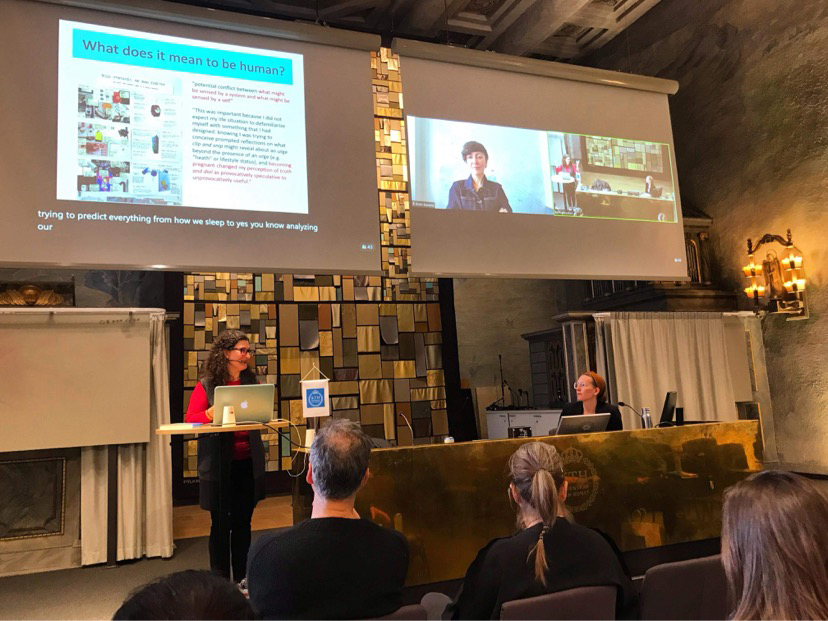
PhD defense!
On Feb 6th 13.00, I’ll be taking a brief intermission from parental leave 👶 to defend my thesis “Designing with care: Self-centered research for interaction design otherwise” ✨ Welcome to join: Kollegiesalen, Brinellvägen 8, Stockholm or on Zoom (https://kth-se.zoom.us/j/67699289253). Abstract below and PDF here!
Opponent: Laura Forlano
Committee: Danielle Wilde, Carl DiSalvo (virtual), Elvin Karana (virtual), Martin Avila
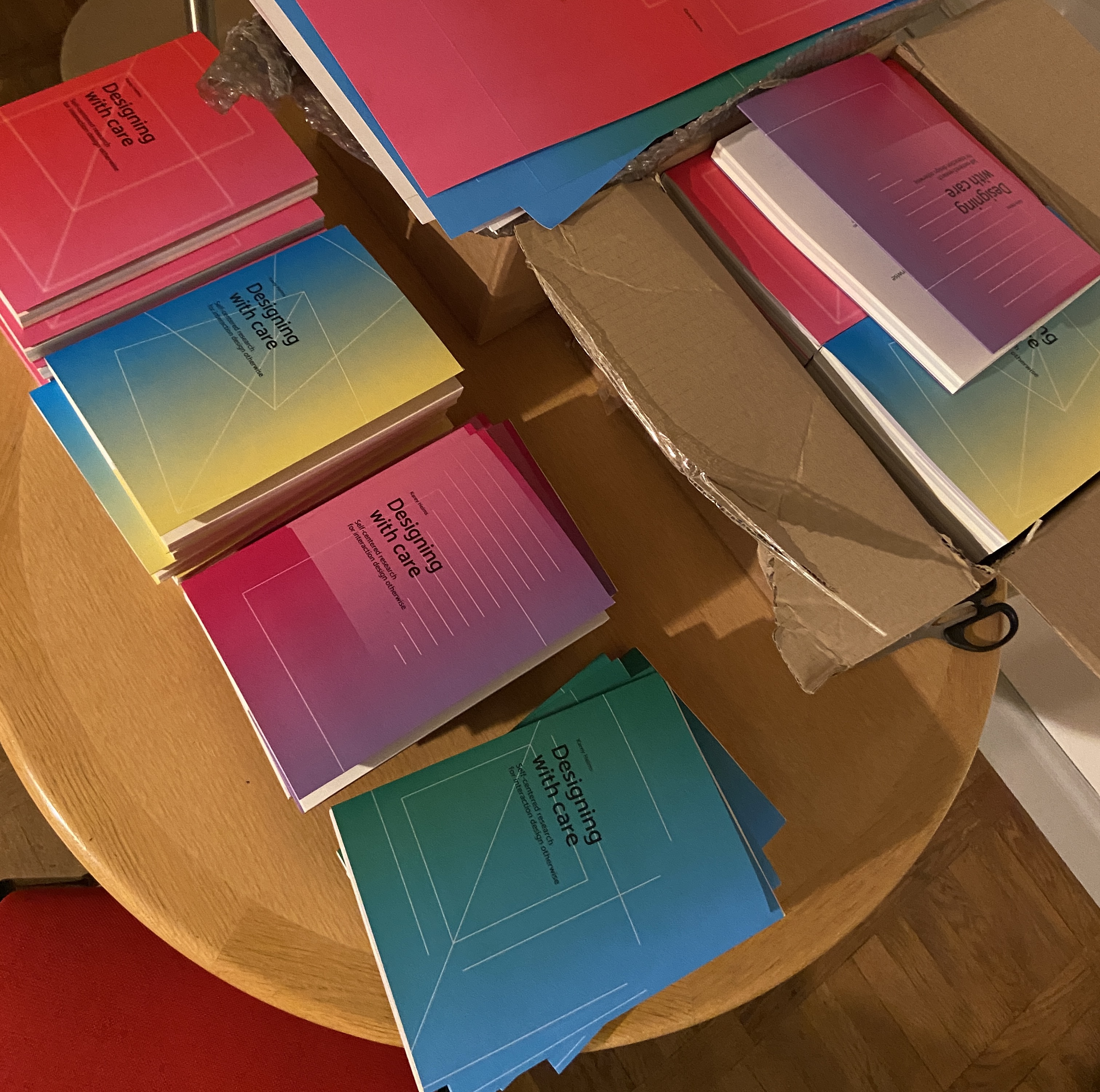
Designing with care: Self-centered research for interaction design otherwise
This dissertation is about the research program designing with care as a pathway towards interaction design otherwise amid a world in crisis. Considering how established ways of doing interaction design will change involves recognizing the role of digital materials in social injustice and systemic inequality. These concerns are inseparable from the material complexity of interactive experiences and their more-than-human entanglements in care. Through five design experiments, I explore everyday human care as wickedly attending to some care doings and not others, and an intimate and generous questioning of oneself as human.
I offer four contributions for interaction designers and design researchers. The first contribution is designing with care. This research program draws upon care ethics and posthumanism to establish four axioms: everyday, wickedness, intimacy, and generosity. Within this programmatic framework, the second contribution is definitions of wickedness and generosity as ethical stances that can be taken by designers and researchers. The third contribution is the synthesis of my four methodological approaches: auto-design, spatial orientations, leaky materials, and open speculations. Each is a generative and analytical pathway towards more sustainable and just futures. The fourth contribution is five careful designs as prototypes of what interaction design otherwise might be like: technologies of human waste, spying on loved ones, leaky breastfeeding bodies, scaling bodily fluids, and a speculative ethics.
From my research program and contributions, I discuss disciplinary resistances to suggest three possibilities for how I argue interaction design should change: engaging with mundane yet unrecognized topics, doing design work where the consequences would be present, and reconsidering how the formats of research publications could better reflect positionality. I then reflect upon the relevancy of self-centered research in moving beyond oneself for more sustainable worlds.
CHI 2022 – Publications
A little over a week ago, I had two papers published at the ACM CHI conference and a position paper shared at the workshop Feminist Voices about Ecological Issues in HCI. Check them out!
Karey Helms. 2022. A Speculative Ethics for Designing with Bodily Fluids. ACM Conference on Human Factors in Computing Systems Extended Abstracts (CHI 2022, alt.chi) New Orleans, LA, USA.
PDF, DOI, Video (8 min), Video (30 sec)
Pedro Sanches, Noura Howell, Vasiliki Tsaknaki, Tom Jenkins, and Karey Helms. 2022. Diffraction-in-action: Designerly Explorations of Agential Realism Through Lived Data. ACM Conference on Human Factors in Computing Systems (CHI 2022), New Orleans, LA, USA. (Best Paper Honorable Mention Award)
DOI, Video (8 min), Video (30 sec)
Karey Helms. 2022. Site-writing around Breastfeeding. ACM Conference on Human Factors in Computing Systems (CHI 2022, Position paper) Workshop “Feminist Voices about Ecological Issues in HCI”, New Orleans, LA, USA.
KTH 2020 IxD Team Exhibition
A couple weeks ago, the Interaction Design team at KTH had an internal exhibition of design projects. Due to the pandemic, whereby we primarily work from home, it has been difficult to engage with each other’s design work. Thus, this exhibition was a chance for us to get together (in line with safe distancing) to share our work! I presented a new side project within my PhD that I started while on maternity leave last year, which I call Free the Nipple. Below are some images of my exhibition space and a draft project description. You can find more of the project’s process (and other project work) on my public instagram account.
GROUP 2020 and CSCW 2019 – Accepted Papers
Very excited to have two papers accepted from an ongoing project on HCI and the outdoors with Airi Lampinen and Barry Brown from Stockholm University and Pedro Ferreira from IT-University of Copenhagen! Below are the abstracts, will post camera ready versions in the coming months. The first in particular and fieldwork that informed both are a precursor to upcoming design work that will ensue in the winter when I return from parental leave.
Away and (Dis)connection: Reconsidering the Use of Digital Technologies in Light of Long-term Outdoor Activities
Karey Helms, Pedro Ferreira, Barry Brown, Airi Lampinen. 2019. Away and (Dis)connection: Reconsidering the Use of Digital Technologies in Light of Long-term Outdoor Activities. ACM International Conference on Supporting Group Work (GROUP 2020), Sanibel Island, Florida, USA.
We present a study of long-term outdoor activities, based on altogether 34 interviews with 19 participants. Our goal was not only to explore these enjoyable experiences, but more broadly to examine how technology use was recontextualized ‘away’ from the everyday. Outdoor activities are commonly presented as an escape from our technology-infused world. In contrast, our interviews reveal experiences that are heavily dependent on technology, both digital and not. However, digital technology — and in particular the mobile phone — is reconfigured when taken out of its ordinary, often urban and indoor, context. We first present a diversity of ‘aways’ during outdoor activities by depicting cherished freedoms and interpersonal preferences. We then describe how participants managed connection and disconnection while away and upon coming back. To conclude, we discuss how constructions of away can support more purposeful engagements with digital technology, and how pointed (dis)connection can be useful for technology design also in non-outdoor settings.
From Nomadic Work to Nomadic Leisure Practice: A Study of Long-term Bike Touring
Pedro Ferreira, Airi Lampinen, Karey Helms, Barry Brown. 2019. From Nomadic Work to Nomadic Leisure Practice: A Study of Long-term Bike Touring. ACM Conference on Computer-Supported Cooperative Work and Social Computing (CSCW 2019), Austin, Texas, USA.
Mobility has long been a central concern in research within the Computer-Supported Cooperative Work (CSCW) community, particularly when it comes to work and how being on the move calls for reorganizing work practices. We expand this line of work with a focus on nomadic leisure practices. Based on interviews with eleven participants, we present a study that illuminates how digital technologies are used to shape and structure long-distance cycling. Our main analysis centers on bike touring as a nomadic leisure practice and on how it offers a radical departure from traditional modes of structuring work and life, and thus, complicates the relationship between work and leisure. We complement this with an account of managing the uncertainties of nomadicity by focusing on participants’ experiences with arranging overnighting and network hospitality. We offer this study, firstly, as one response to the call for more diversity in the empirical cases drawn upon in theorizing nomadic work and leisure practices, but more productively, as an opportunity to reflect upon the temporal and spatial logics of digital technologies and platforms and how they frame our attitudes towards the interplay between work and leisure.
KTH 2018 PhD Supervisory Panel
Today was our department’s annual PhD Supervisory Panel at KTH during which PhD students are given the opportunity to get feedback from senior researchers who act as “guest supervisors.” To prepare for my meeting with two Associate Professors I reworked my research abstract and research questions following my 30% seminar in October, during which Johan Redström from Umeå Institute of Design acted as my discussant. My goals in today’s supervisory panel were to get feedback on the new scope of my abstract and research questions relative to being only about 40% through my PhD (and I’m sure will continue to evolve), and identify important areas that I need to work on articulating to more firmly position my research in the context of how I am conceptually “furnishing” my design space. Considering I was presenting to senior researchers from different academic backgrounds than my own and each other, it was especially helpful to see within which aspect I felt misunderstood, i.e. where I need to sharpen my arguments. Below my poster summarizing my research thus far, followed by a few notes/reflections based on feedback received today, and a textual version of my abstract and research questions.
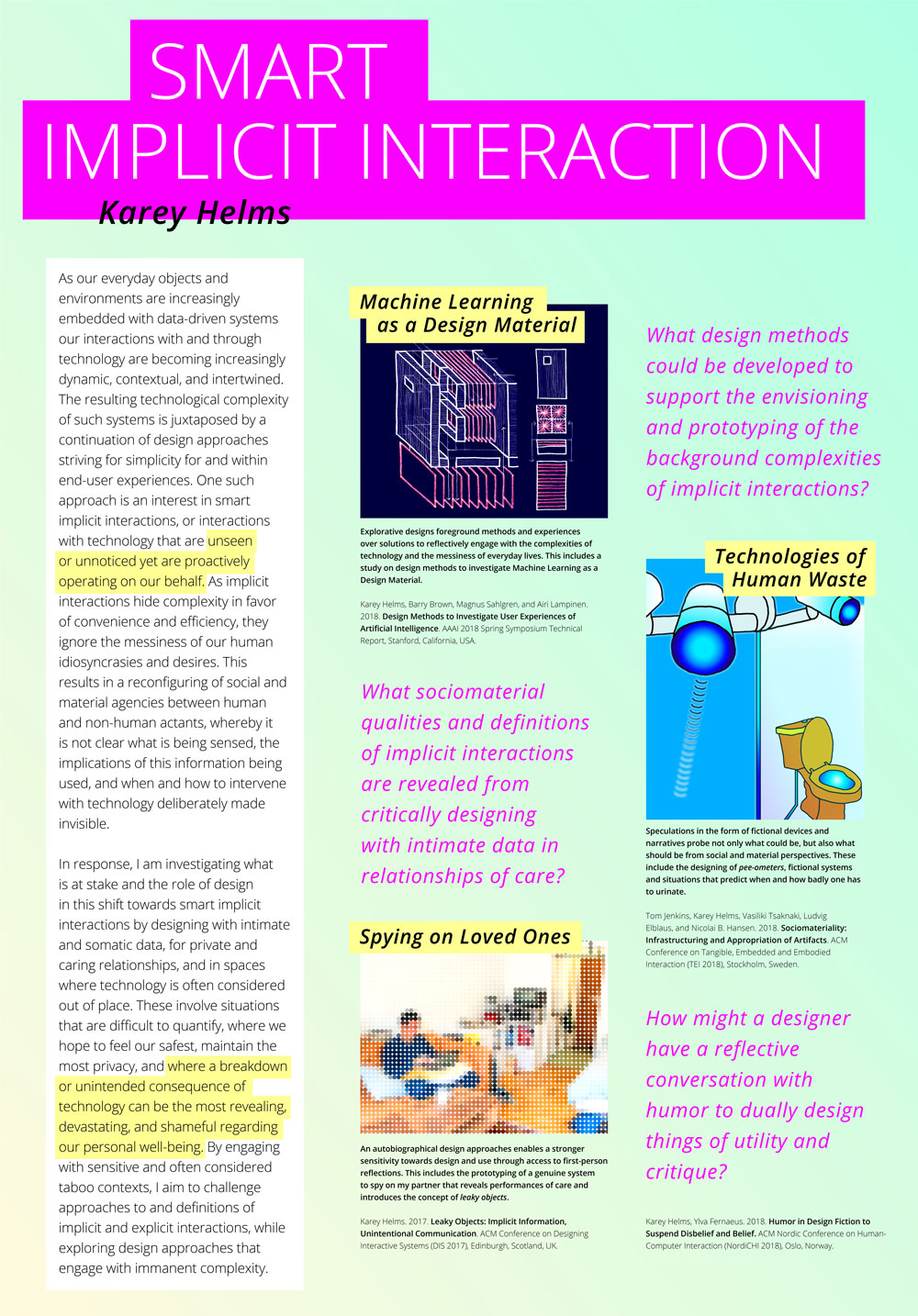
Design Briefs – Spying on Loved Ones & Tangible Designs for Effort, Exertion, and Exhaustion
For this year’s Advanced Project Course in Interaction Design at KTH, I’m fortunate and excited to have two groups of second-year master’s students working with me on two project briefs – Spying on Loved Ones and Tangible Designs for Effort, Exertion, and Exhaustion during Outdoor Experiences. Excited to see their resulting design work in December!
Spying on Loved Ones
To spy on someone is commonly thought of as a negative or harmful act during which one person secretly observes or collects information on another for malicious purposes. Yet, we also “spy” for many positive reasons. For example, these might include watching a sleeping child through a baby monitor, checking a partner’s calendar to plan a surprise birthday party, or browsing the fridge of an elderly parent to ensure a healthy diet is being consumed. What these examples have in common is that they are acts of care. This projects investigates how we care for others through technology, both with technologies explicitly designed to survey or observe others and through technologies designed for other purposes yet leak implicit information that enables spying. Within this investigation, various forms of spying will be classified and critiqued, the social and cultural implications of these positive intentions with be explored, and speculative prototypes will be designed to either further enable or inhibit spying.
The project will follow the suggested steps: (1) a review and critique of technologies explicitly designed for spying in private and public spaces, (2) investigation into ways in which people spy on others through technologies not designed for spying, possibly through workshops, interviews, or cultural probes, (3) the design of speculative prototypes to either further enable or inhibit spying, resulting in an ecology of physical artifacts. Required skills include strong design sensibilities and an interest in critical design and design fiction.
This project builds upon Leaky Objects: Implicit Information, Unintentional Communication.
Tangible Designs for Effort, Exertion, and Exhaustion during Outdoor Experiences
Multi-day outdoor activities such as hiking, skiing, cycling, and horseback riding involve full body engagement, during which bodies become sore and often endure physical transformations. Yet despite perceived discomfort and difficulties, outdoors experiences are often considered rewarding and relaxing. Thus, rather than designing to make these activities easier or more comfortable, this project investigates designing tangible artifacts and devices to celebrate or enhance these experiences of effort, exertion, and exhaustion. This project is part of a broader, ongoing outdoors project within the Smart Implicit Interaction project, and has the opportunity to build upon recent interviews with participants who have engaged in long-term outdoors experiences.
The outcome of the project is open-ended, but students are expected to engage in a design process to that result in novel artifacts that are either proposed objects of use (e.g. products) or result in interesting new learnings (e.g. cultural probes). Students should have a design background or be interested in following a design process.
Advanced Project Course in Interaction Design at KTH
Loved being a part of the Advanced Project Course in Interaction Design with Jarmo, a colleague at KTH! In this new course that took place this past fall (2017), students carried out a small research project in close collaboration with KTH researchers. In addition to assisting with course admin and examination, I also supervised a group of three students working on a pee-ometer – a device that predicts when someone has to pee – for my research on implicit interactions and machine learning as a design material. Looking forward to running the course again this coming fall!
PhD’ing – Writers’ Retreat, Project Offsite, Outdoors Research, and Making Preciousness
Today I saw a meme on Instagram which said, “We are now entering the third month of January.” I couldn’t relate more! And looking back over the past few weeks, cannot believe all that has already happened in 2018.
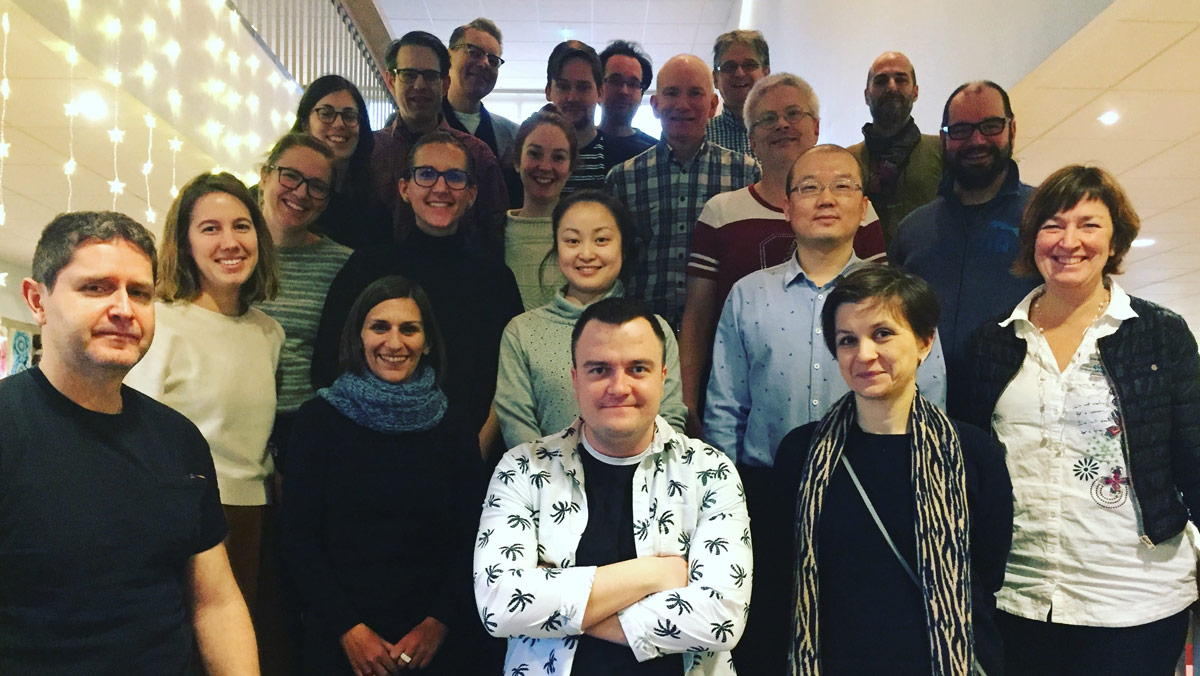
Writer’s Retreat
Following a paper deadline in early January, my department at KTH (Media Technology and Interaction Design) kicked off 2018 with a writers’ retreat. What happens at a writers’ retreat? We book a venue in the Stockholm archipelago for three days and two nights, and write. And sauna and winter swim, but mainly write. The primary purpose of the retreat is to provide time and space away from everyday academic duties, from teaching to admin responsibilities, in order to focus on increasing the quality and quantity of our writing output. During the three days, we follow an agile framework in which junior/senior pairs write in ~45 minute sprints and then provide ~15 minutes of feedback. In addition to intense writing blocks, lunches, dinners, and evening activities provide ample opportunities to better know our colleagues professionally and personally. Though equally as exhausting as the writing, this social time I find incredibly valuable in creating a continued collaborative culture at work.
During this year’s writing camp I started a paper on a Pee-ometer, a recent project by Master’s students that I proposed and supervised in which they prototyped a wearable device that predicts when a user has to pee to investigate Machine Learning as a design material.
Project Offsite
In mid January, the Smart Implicit Interaction project had a two day project offsite. As the project is composed of differing philosophical and methodological backgrounds – i.e. Artificial Intelligence, Social Sciences, and Interaction Design – the first day consisted of a beginners overview into reinforcement and representational learning in neural networks to introduce technical terminology and objectives. During the second day, all of the sub-projects presented their current status and goals for the year. I specifically presented two ongoing design projects, data-driven design methods and the Pee-ometer. In the former, I discussed early design activities and resulting concepts from investigating the implications of screenshots as a data source. In the latter, I discussed three high-level interests guiding future project directions, including Machine Learning as a design material, interactional loops, and critique and ethics. Overall, it was inspiring to share and strategize better collaborations while revisiting overarching project objectives.
Project Offsite
Last week continued January’s streak of out-of-office research activities and into the forest. To kick off an new outdoors project, myself and three senior researchers went on a mid-week day hike 30 minutes outside of Stockholm. Not only was I surprised at a Professor’s ability to make a fire in the snow, but the excursion was both refreshing and constructive. More in the coming months!
Making Preciousness
And last but definitely not least, friend and fellow PhD student Vasiliki successfully defended her thesis Making Preciousness: Interaction Design Through Studio Crafts. Her opponent Ron Wakkary gave a much deserved brilliant presentation of her work before lengthy discussions with him and the committee. Admittedly, it is selfishly bittersweet to see her finishing as she has been a tremendous support and inspiration during the first year of my own PhD.
TEI 2018 – Studio Call for Participation
Sociomateriality: Infrastructuring and Appropriation of Artifacts
Novel materials and innovative applications can sometimes outweigh a reflective perspective on the roles that objects and materials can play in social life. In this Studio, we want to bring together researchers and practitioners who are interested in exploring design outcomes from a sociomaterial perspective. By having prototypes at the center of the Studio activities, we intend to create prompted speculative fictions that link the material outcomes of design practice to social agency and cultural effects.
This studio will offer an opportunity to examine how objects might participate in social spheres as well as act as material bridges to their design process. We will do this through both hands-on examination of design objects, and inquiry into the infrastructuring and appropriation of these artifacts. The themes that will be examined are agency, material participation, and cultural performance of things. We encourage participants to bring their own prototypes.
We invite scholars and design practitioners from a variety of fields to register on the TEI 2018 website. For any questions, email the workshop organizers at mailto:hello@sociomaterial-things.com.
For any questions, email the workshop organizers at:
mailto:hello@sociomaterial-things.com.
More information you can find at the Studio webpage:
http://sociomaterial-things.com
Organizers
Tom Jenkins – Georgia Institute of Technology
Vasiliki Tsaknaki – KTH Royal Institute of Technology
Karey Helms – KTH Royal Institute of Technology
Ludvig Elblaus – KTH Royal Institute of Technology
Nicolai Brodersen Hansen – TU Eindhoven
PhD’ing – Taboo, Tinkle, Algorithms, and Home
For an autobiographical project building off Leaky Objects, in which I’m allowing myself to undertake a significantly slow design process, this week I read Geography of Home: Writings on Where We Live by Akiko Busch. The book is a collection of beautiful musings organized by room and touches upon notions of comfort, dichotomies between possessions and spaces, clutter, deeply personal rituals, thresholds, processions, and changing functionalities. So much I love in this book while mapping the geography of our tiny home which defies all traditional expectations and conditions. Last year before moving from London to Stockholm, we read The Life-Changing Magic of Tidying Up, an amusing read that we nevertheless abided by and asked everything we own, “Do you bring me joy?” Not only did we end up giving away bags of stuff, but it also prompted many meaningful discussions regarding and aligning views on possessions and a home, in addition to musings around if someday everything will be connected, will all our possessions? And why do we keep them, and do we deserve them if possession implies care, custody, and guardianship? More and more through many of my ongoing projects and initial concepts, I realize I’m interested in overlaps between privacy and care, and perhaps comfort too.
A project I recently started with MSc students is investigating predicting pee habits, which to many is a taboo topic due to the invasive nature of the proposed interaction and an aversion to recognizing private bodily functions. A subsequent discussion with my supervisor on researching taboo topics led to the reading of the paper Accountabilities of Presence: Reframing Location-Based Systems and the website Between the Bars: Human Stories from Prison. In the paper, the authors research paroled sex offenders who are tracked via GPS to explore the intersection between mobility, presence, and privacy; while the website offers a digital platform to share handwritten content from people in prison who do not have access to internet. In both cases, what could be considered extreme or fringe users are researched or designed for, and equally interesting for different reasons, they also serve as interesting case studies that either directly learn from or address the messy realities of society. One of my biggest peeves – designers don’t address the messiness of life nearly enough. So while pee might not be prison, it is definitely an everyday and occasionally very messy, mundane, and universal reality that should not be ignored as I believe there is much to be gained from deviating from designing only delightful experiences.
On a fun, related note, I recently found out that Engelbart conceived what he called the “tinkle toy”, a small waterwheel in a toilet bowl that would spin when pee was run over it, serving as a potty-training aid for boys as the interaction was designed to be an incentive to pee in the toilet. From Markoff’s What the Dormouse Said: How the Sixties Counterculture Shaped the Personal Computer Industry.
A week or two ago, it was difficult to miss Algorithms as culture: Some tactics for the ethnography of algorithmic systems on Twitter. Found it incredibly informative and a nice compliment to Dourish’s The Stuff of Bits: An Essay on the Materialities of Information, which I started last week for implicit interaction book club. The paper also led me to these slides The algorithm multiple, the algorithm material: Reconstructing Creative Practice – in which I was thrilled to see my former UVa architecture professor and brief employer Jason Johnson of Future Cities Lab mentioned.
Lastly, this morning I found this open source software by Rebecca Fiebrink for real-time, interactive Machine Learning that hopefully I can use with Arduino.
PhD’ing – Wonder, Autonomy, Frameworks, and Infrastructures
Trying something new with the aim of semi-regular updates regarding what I’m reading, working on, and thinking about.
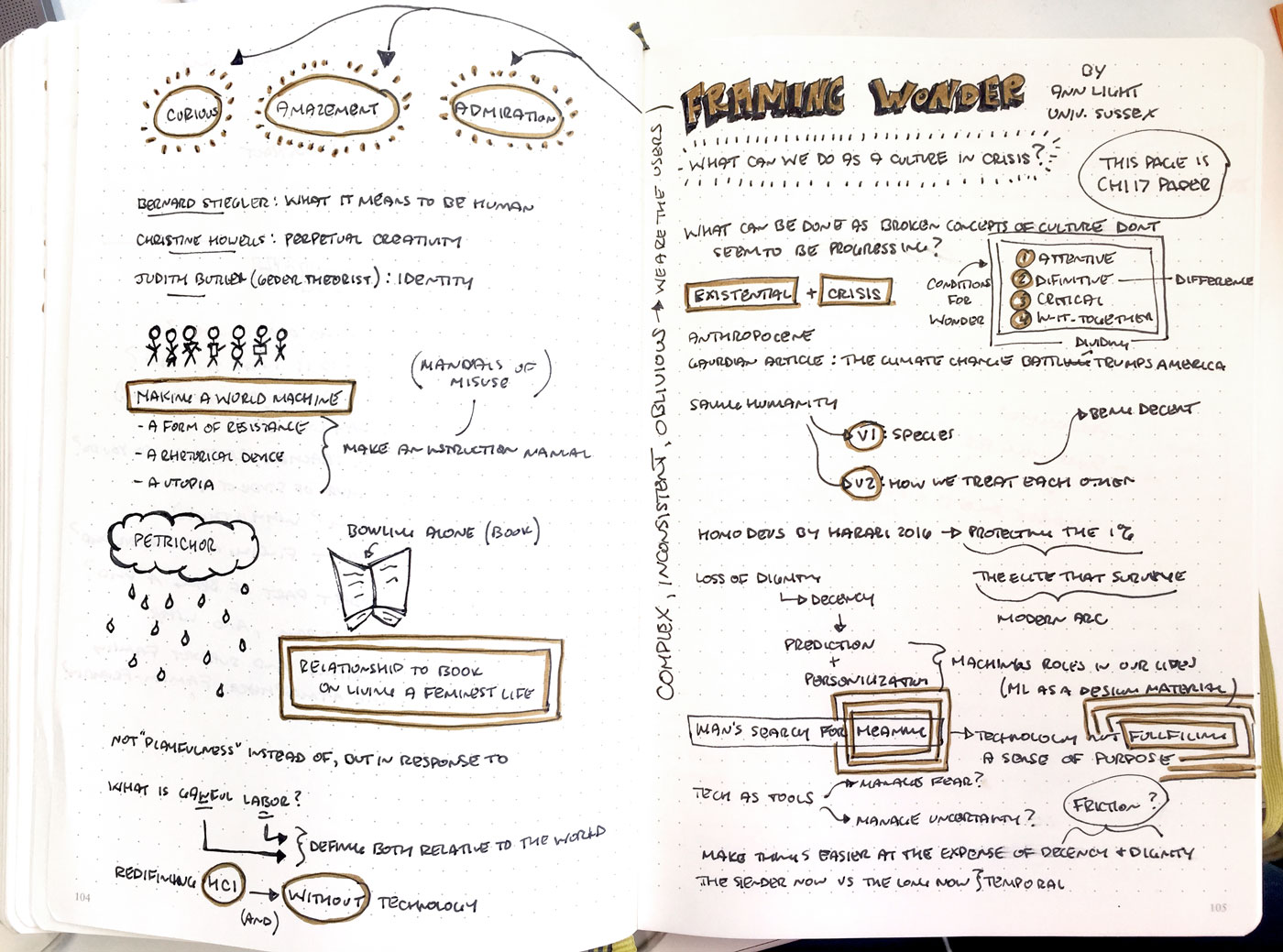
Last week had a short chat with Ann Light from the University of Sussex regarding my work and attended her guest lecture Framing Wonder: Beyond Design for Existential Crisis (sketch notes above). Dark yet very inspiring talk and highly recommend her related paper Design for Existential Crisis from CHI17. Both the talk and her paper inspired me to look into care ethics and feminist theory regarding my work.
For a recent paper and my ongoing multi-disciplinary project work, have been thinking a lot about Terry Winograd’s Shifting viewpoints: Artificial intelligence and human–computer interaction, in particular how to work across philosophical and methodological differences.
Based on a colleague recommendation, recently listened to Our Robots, Ourselves: Robotics and the Myths of Autonomy by David Mindell, a very accessible contribution to discourse on the meaning of autonomy. Throughout the book, within each of many case studies, he repeatedly challenges listeners (readers) to ask, ‘Where are the people, which people are they, what are they doing, and when are they doing it?” as he proposes an emphasis on human-computer relationships rather than the idea or potential of replacement. My favorite of his examples regards remote control of Mars rovers from Earth bound operators and the coinciding debate if presence can be felt at such a distance and with significant time delays – is remote presence real presence?
Last week discussed Things That Keep Us Busy: The Elements of Interaction by Lars-Erik Janlert and Erik Stolterman in a research book club with a focus on Implicit Interaction. I found the book an easy read as it was very much like a collection of papers (which most of it draws from). While I appreciated the provision of definitions, frameworks and objective perspective – as in taking the object’s instead of the user’s perspective – overall there was much I disagreed with, in particular the notion that implicit interaction decreases interactivity, and found it difficult to maintain a narrow perspective that doesn’t regard the social or systemic implications. Perhaps also, it seemed to contrast philosophically with Dewey’s Art of Experience which I am reading for a PhD course on the theoretical foundations of UX, and as a design researcher situated in a technical university am over-resisting the application of frameworks upon a field dependent on embracing the subject, chaotic, and messy nature of the world.
Attended a great talk by my friend Lorenzo at IxDA Stockholm’s event Questions and answers in the design process with Nordic Morning. Great nuggets regarding the materialization of cultures to engage people in discourse and materialization of infrastructures to enable designers to transform them. Definitely calls for a revisit of his paper Materializing infrastructures for participatory hacking.
Lastly, in addition to a bunch of course grading, this week I’ll be continuing concepts derived from a recent project workshop on designing with data and starting a new project with three KTH master’s student on prototypes to probe the notion of training when approaching Machine Learning as a design material. A related paper includes UX Design Innovation: Challenges for Working with Machine Learning as a Design Material.
EuroIA 2017 – Smart Implicit Interactions
Two weeks ago I had a lovely time speaking about my current research interests and questions surrounding Smart Implicit Interactions with industry practitioners at EuroIA 2017 in Stockholm!
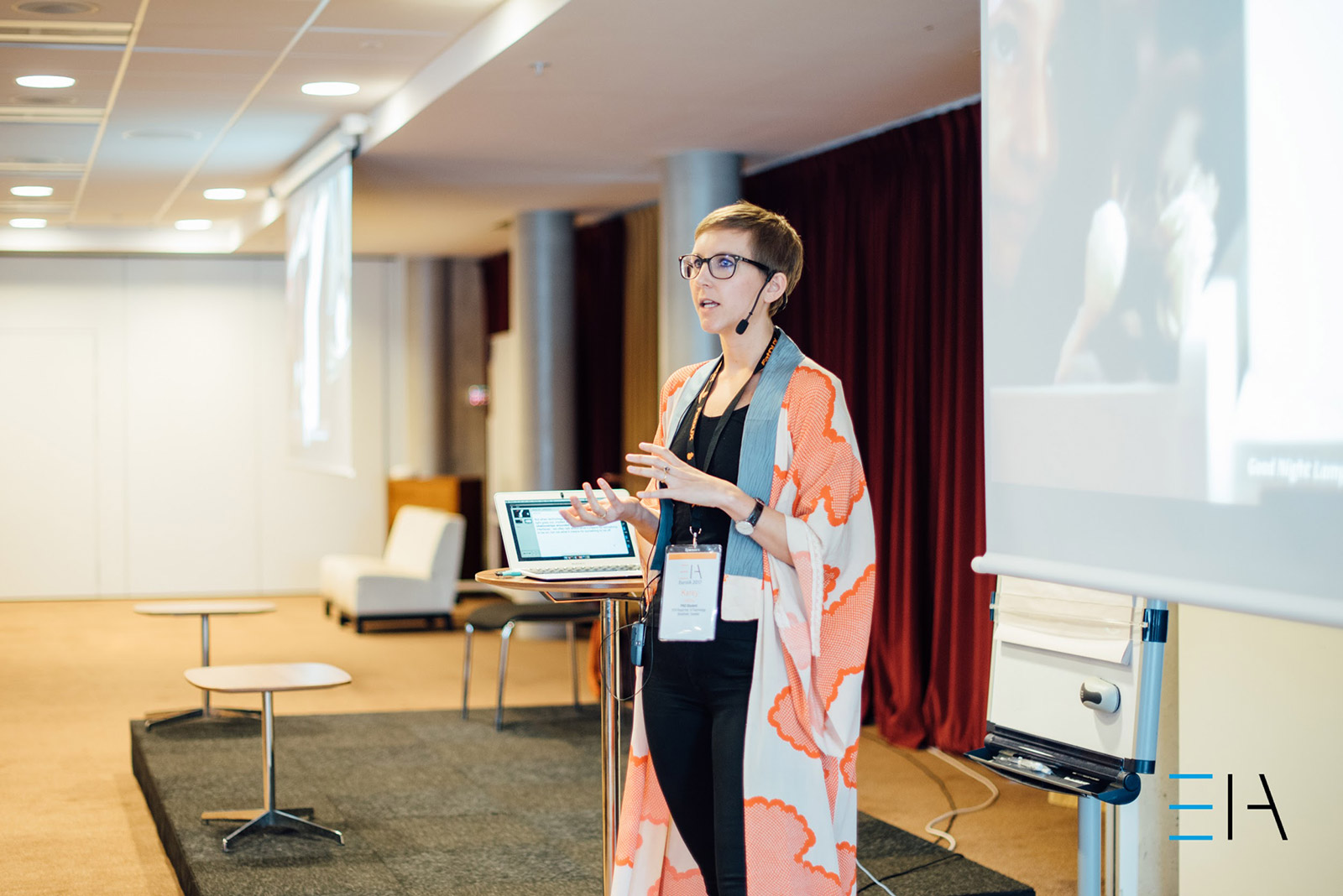
Thanks EuroIA for the INTENSE photo above and Inge Nahuis for the sketchnotes below!
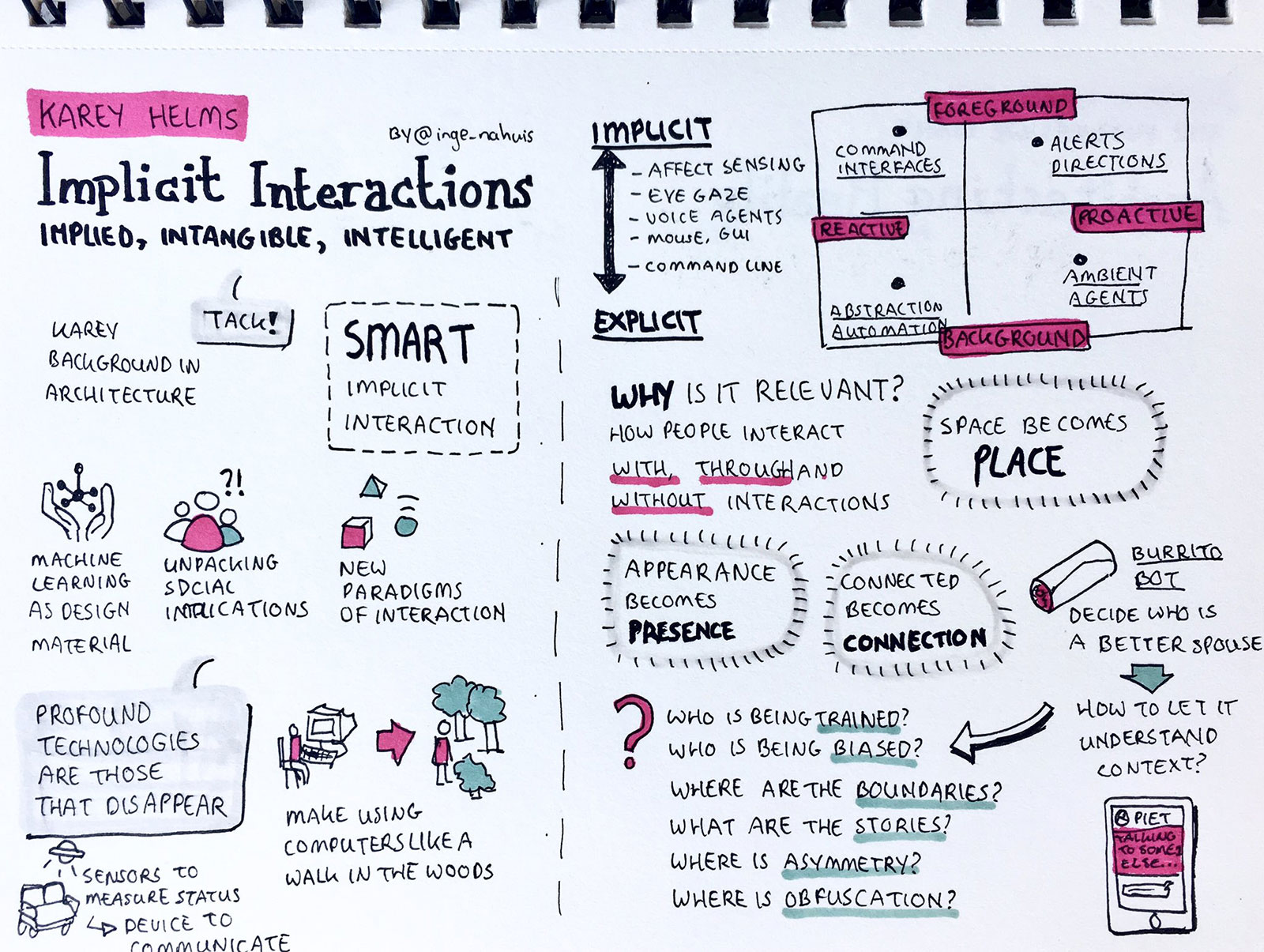
EuroIA 2017 – Upcoming talk on Implicit Interactions
Very excited to be giving a 20 minute talk on September 30th at EuroIA in Stockholm on Implicit Interactions: Implied, Intangible and Intelligent! Below is my talk abstract.
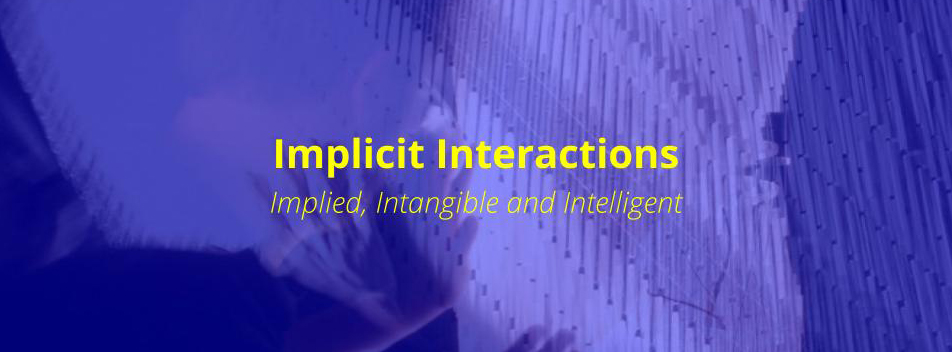
As our physical and digital environments are ubiquitously embedded with intelligence, our interactions with technology are becoming increasingly dynamic, contextual and intangible. This transformation more importantly signifies a shift from explicit to implicit interactions. Explicit interactions contain information that demands our attention for direct engagement or manipulation. For example, a physical door with a ‘push’ sign clearly describes the required action for a person to enter a space. In contrast, implicit interactions rely on peripheral information to seamlessly behave in the background. For example, a physical door with motion sensors that automatically opens as a person approaches, predicting intent and appropriately responding without explicit contact or communication.
As ambient agents, intelligent assistants and proactive bots drive this shift from explicit to implicit interactions in our information spaces, what are the implications for everyday user experiences? And how do we architect dynamic, personal information in shared, phygital environments?
This talk aims to answer the above questions by first introducing an overview of explicit and implicit interactions in our mundane physical and digital environments. Then we will examine case studies in which unintended and unwanted consequences occur, revealing complex design challenges. Finally, we will conclude with example projects that explore a choreography between explicit and implicit interactions, and the resulting insights into architecting implied, intangible and intelligent information.
Design Brief – Manuals of Misuse
Below is the design brief that I wrote for the master’s level course in which I am a Teaching Assistant. The course is Interaction Design as a Reflective Practice.
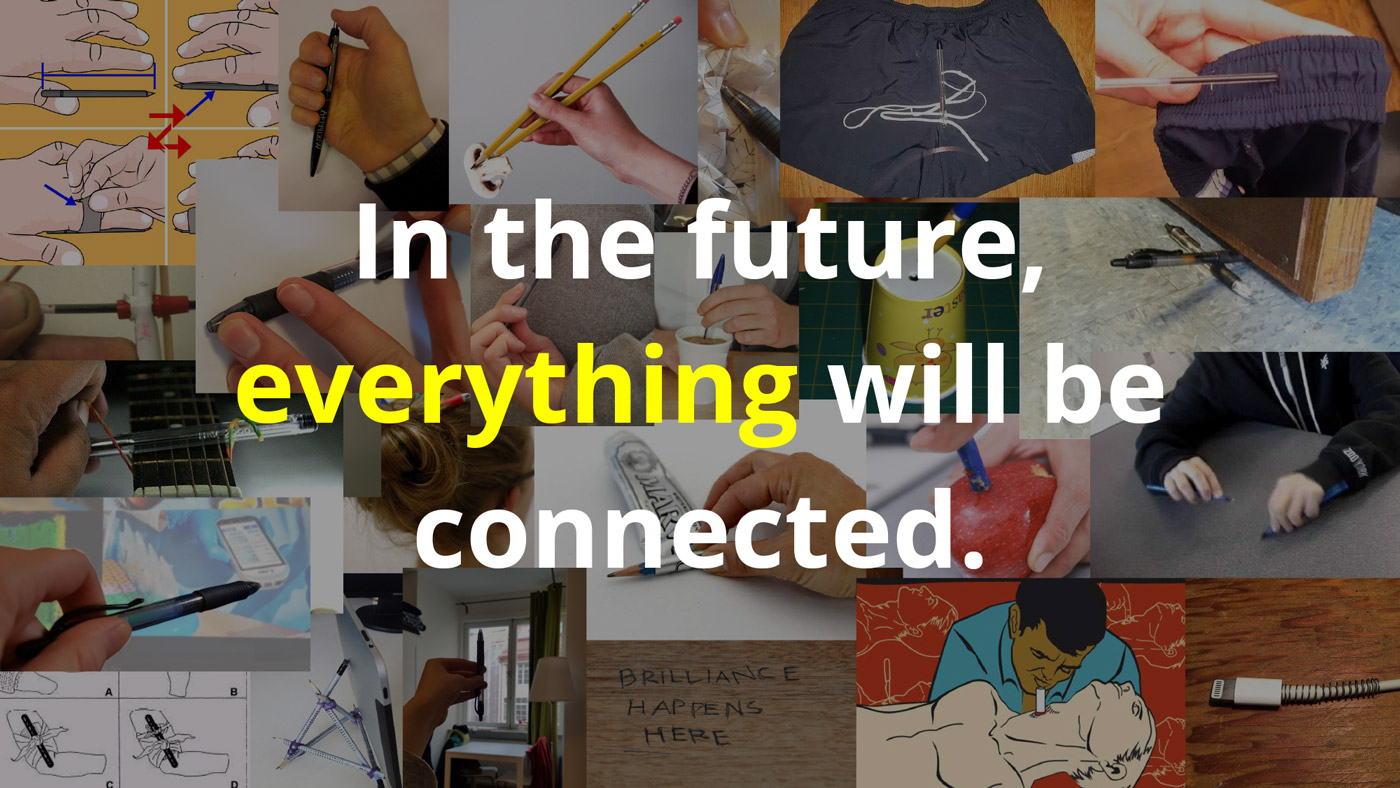
Design Brief
Technological forecasts often predict that someday in the future everything will be connected. What is everything? And why is connected so often synonymous with tangible interactions being transferred to mobile applications or voice-based assistants? Additionally, these solutions primarily focus on efficiency and automation, signaling a shift from engagement to a frictionless relationship with technology. Is this shift necessary, or do our physical things have overlooked abilities, hidden meanings or magical uses?
The project Manuals of Misuse investigates these questions by examining our everyday interactions with faceless objects and reimagining how they might be misused to playfully control or meaningfully communicate with other things, people or places.
You will do this by:
- Reflecting upon the intended interactions of an everyday object of your choice
What is the essential use of the object and the ideal scenarios of interactions? - Communicating how the object is meant to be used, interacted with and part of an ecosystem
What information is needed to communicate to a novice user, product partner, or manufacturer? - Investigating how the object is or could be misused – used for purposes not intended by the designer
What are the object’s properties and/or affordances that result in these misuses? - Generating novel design concepts of playful, meaningful or magical misuse
What modifications, interactions and technologies are required to make this possible? - Creating a stand-alone, multimedia experience that conveys your reimagined misuse
What is needed to communicate the essence of your concept and prompt further investigation?
Objectives
- Reflection: Upon our mundane, micro interactions with everyday objects. How to we use things and why do we use, or misuse, them? What can we learn from misuse and how does it inform how open or closed we design for appropriation?
- Communication: Of design intent, technical specifications and user experience to diverse audiences through various mediums.
- Playfulness: For engaged action and meaningful interaction.
- Documentation: For reflection and communication.
Industry to Academia, London to Stockholm
This week marks a big transition as I leave the complexities of enterprise UX at Zebra Technologies to pursue a PhD in Smart Implicit Interaction at KTH in Stockholm as part of a newly formed research group. My academic statement of intent below perhaps best expresses the culmination of my past experiences leading to my forthcoming journey. And the photo is of course just one of the many fond memories I will take with me.

Statement of Intent
“You think that because you understand ‘one’ that you must therefore understand ‘two’ because one and one make two. But you forget that you must also understand ‘and’.” ~ Sufi teaching story (Meadows, 2008)
Interests
On my first day of architecture school, we were asked to diagram where we come from and where we are now using a only a series of lines and dots on index cards. At the time, I was baffled by the task of reducing a complex, dynamic, and intimate answer into such simplistic, static, and impersonal elements. While this assignment ultimately ignited my interest in the pieces and processes of emergent systems and how the unique relationships between individual components inform and define the greater whole; more importantly, it cultivated analytical and divergent thinking. I learned how to isolate core components from a system, define explicit interactions in a space, situate functions within a context, and map parametric flows across time. Though eventually, my career pivoted from architecture to design as my intent transitioned from delight to meaning, and thus my thinking transformed from analytical to synthetic.
The primary differentiator between my experiences in architecture and design has been the latter’s focus on creative problem solving, or the convergence of disparate elements, activities, and intents to foster meaning. People have become the focus and embodied interaction the goal as I have strived to understand how space becomes place and appearance becomes presence. As an Interaction Designer, I design how people interact with, through, or without technology – an infinite and inclusive definition that ultimately focuses on people and prepositions, as it is the relationships that concern me. But as objects, environments, and worlds become ubiquitously intelligent, networked, and augmented, these relationships become increasingly dynamic, contextual, and intangible. I believe that negotiating these evolving relationships – to ultimately design meaningful new interaction modalities – is an exciting, challenging, and significant opportunity. Thus, I am interested in architecting the synthetic.
Pervasive and with unbounded potential, the “Internet of Things” is the key catalyst and instantiation of this paradigm shift towards implicit interactions. Moreover, as IoT infiltrates the mundane moments of our daily lives, it has the ability to transform our quality of life and achieve efficacious new futures from life-saving wearables to intelligent infrastructures. Though due to its systemic and embedded nature, both participative frameworks and contextual interventions are needed (as interaction is reciprocal), and thus both designs and the environments by which designers and users occupy, must be regarded. This duality necessitates divergent and convergent thinking, with a careful consideration of constraints, contexts, and intents. Therefore, through critical practice, ethnographic research, and situated prototypes, I aspire to explore what could be and what should be the intelligent dialogues of mediated, smart environments.
Capabilities
Over the past decade I have been afforded opportunities professionally, academically, and independently to cultivate the necessary skillset for the pursuit of a PhD in Interaction Design. Following the completion of my BS in Architecture, for over four years I was primarily self-employed as an Interaction Designer and Front-end Developer, working directly with clients from contract to concept to deployment. During this time, I was fortunate to work with a vast array of clients, expanding my formal digital design skills encompassing personas, user flows, information architecture, visual design, and UI development. Though more importantly, the empirical knowledge gained – pertaining to interpersonal and leadership skills, rigorous self-directed scheduling, and end-to-end digital product management and development – has been most invaluable.
My return to academia for my MFA in Interaction Design at Umeå University in 2012 was sparked by a desire to merge my physical and digital backgrounds within a formal user-centered education. My time in Umeå was marked by diverse and immersive collaborations with both peers and industry partners alike, who provided boundless intellectual stimulation while broadening my perspectives. I learned how to think critically and share imaginatively, perhaps best demonstrated in my speculative design thesis. Driven by a passion to critique and challenge society’s relationship with energy, I constructed a near future fictional society in which citizens are required to produce all the energy they desire to consume. Through liminal spaces and diegetic prototypes, I provoked polemical and productive dialogues, which were an engaging end to a wonderful graduate experience.
Following Umeå I moved to London and became a Senior Interaction Designer on the Innovation and Design Team at Zebra Technologies, an enterprise Internet of Things company. Within the constraints of business co-creation and the freedom of internal initiatives, my work investigates a product shift from isolated hardware and software to integrated systems and agents. In particular, I seek to design appropriate solutions at relevant fidelities that can enhance the cognitive and physical abilities of situationally disabled users in data-centric environments. For example, I am the Design Lead in a long-term co-creation project with a global transportation and logistics company seeking to improve organizational and workflow processes through custom 3D imaging technology and edge analytics. Besides traditional UX deliverables, my role includes ethnographic research, empathy mapping, stakeholder communication, service design, and a constant negotiation between implementable and transformational near future visions.
In addition to my role at Zebra, I actively engage in personal side projects which I playfully call “self-centered design.” Within these hypercritical explorations, I prototype manifestations of invisible interactions from the mundane moments of my daily life to gain insights into embodied interaction and socio-technical systems. Two ongoing projects are “Phygital Party Mode” and “Burrito.” The former is a phygital representation of online visitors’ interactions with my portfolio via Google Polymer, Firebase, Arduino, and Philips Hue technologies. Burrito is a manifestation of my marriage in the form of a bot that makes judgements on our relationship based on a mutually defined algorithm. Though perhaps a bit bonkers, both prototypes have resulted in instrumental insights that technically and creatively impact my professional development.
Motivation
My motivation to be a doctoral student is a combination of passion for the subject, drive to innovate in an immersive environment, desire to collaborate on a highly capable and motivated research team, and aspiration to contribute to academia via teaching. Throughout my educational background thus far, I have been fortunate to learn, collaborate, and contribute within competitive academic environments that seek and attain meaningful innovation. At both the University of Virginia and Umeå Institute of Design, I experienced firsthand the productive synthesis of cross-disciplinary participation and student-faculty engagement. These relationships were not only instrumental in my own development, but more importantly, contributed to the progress of meaningful experiences, emerging technology, and imaginative new futures. With diligent analysis and thoughtful synthesis, I would love to continue this trajectory at KTH with an inspiring team at a leading institution, and can guarantee that in addition to my credentials, I bring a healthy dose of gumption.
Meadows, Donella H. (2009). Thinking in Systems: a Primer. London, UK: Earthscan.